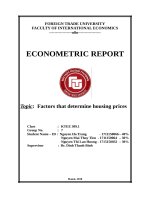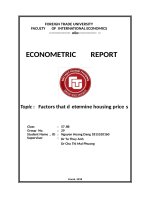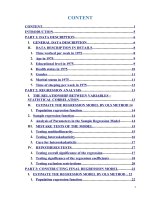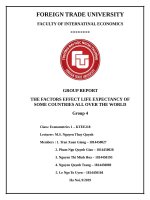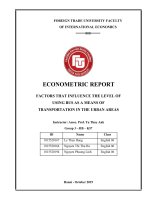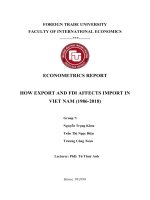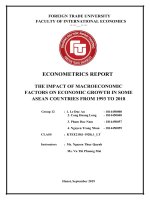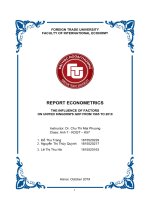tiểu luận kinh tế lượng factors affecting average height of countries in the world
Bạn đang xem bản rút gọn của tài liệu. Xem và tải ngay bản đầy đủ của tài liệu tại đây (359.19 KB, 21 trang )
FOREIGN TRADE UNIVERSITY
FACULTY OF INTERNATIONAL ECONOMICS
-----*****-----
ECONOMETRICS REPORT
Topic: Factors Affecting Average Height
Of Countries In The World
Students: Luyen Quang Hieu – 1815520173
Hoang Lan Huong – 1815520176
Pham Thu Hai – 1815520165
Group: 06
Class: English 7 – K57
Major: Japanese International Business
Instructor: Assoc. Prof. Dr. Tu Thuy Anh
Hanoi, October 2019
TABLE OF CONTENTS
I.
ABSTRACT................................................................................................................................................... 2
II. INTRODUCTION......................................................................................................................................... 3
III.
LITERATURE REVIEW......................................................................................................................... 3
IV. THEORETICAL BACKGROUND............................................................................................................... 5
1.
Human height....................................................................................................................................... 5
1.1. Human height.................................................................................................................................... 5
1.2. Human height around the world............................................................................................... 6
2. Factors affecting the average height of countries........................................................................ 7
2.1. Health expenditure......................................................................................................................... 7
2.2. Air quality index (AQI).................................................................................................................. 8
V.
DESCRIPTIVE STATISTICS OF DATA....................................................................................................9
1. Research model........................................................................................................................................ 9
1.1 Overview of the study..................................................................................................................... 9
1.2 Sign expectation of the parameters........................................................................................... 9
1.3 Meaning of the parameters........................................................................................................... 9
2. Statistics description........................................................................................................................... 10
2.1. Graph................................................................................................................................................. 10
2.2. Summary statistics....................................................................................................................... 10
3. Correlation matrix................................................................................................................................ 11
VI. ECONOMETRICS MODEL....................................................................................................................... 11
1. Regression model (OLS method)..................................................................................................... 11
2. Testing an individual regression coefficient (T-test)...............................................................12
3. Testing the overall significance (F-test)........................................................................................13
VII. ROBUSTNESS CHECK.......................................................................................................................... 13
1. Multicollinearity.................................................................................................................................... 13
2. Normality................................................................................................................................................. 14
3. Heteroscedaticity.................................................................................................................................. 14
VIII. FINDING AND DISCUSSION............................................................................................................. 15
1. Finding...................................................................................................................................................... 15
2. Discussion................................................................................................................................................ 15
IX.
CONCLUSION.......................................................................................................................................... 17
REFERENCES..................................................................................................................................................... 18
APPENDIX.......................................................................................................................................................... 19
1
I.
ABSTRACT
In the developing lives nowadays, height is a problem of which everyone is
concerned. Not only directly related with health, it is also a basic requirement of
many jobs and work, moreover, it provides a lot of advantages to our daily lives. So,
which are the factors that determines the human heights in each individual ?
Scientists said that genetic factors take up to 60 to 80% in affecting each person’s
final height. After that, through various research processes regarding the
components that can affect human height in many countries, it came to the final
conclusions, showing that nutrition is the major factor which has the most effect on
height. According to many researchers from countries around the world, the growth
in physique and body of young children are directly affected from nutrition condition
in their daily meals. A child’s height is only 23% influenced by genetic component
( from their grandparents and parent’s gene ), while nutrition contributed up to 32%.
In this research, we decided to focus our research on the other factors besides
nutrition and genetic which also has the significant effect on the average human
height around the world. Recent studies showed that the Vietnamese male placed
19
th
among the countries which has the lowest average height, which is 164,4cm,
Vietnamese female placed 13
th
among the countries which has the lowest average
height around the world, approximately 153,4cm. From here, we want to give out
some recommendations for improving the average height for Vietnamese people.
2
II.
INTRODUCTION
Thanks to the many achievements in technology and scientific technique, the world
we are living in nowadays is continuously thriving in every aspect. The living quality
of human keeps on being improved, humans get to live in a better conditions day by
day. From there, there is a lot of elements directly and indirectly influencing the
average height of the citizens of different countries in the world. This studies will
focus on analyzing those factors. We hope it will contribute for other researchers to
keep on looking into this topic in a deeper level and rationally give out improvements
on the average height for each individuals.
Using the regression analysis, this study can determine how important the factors
are to the average heights. Once the regression equation is estimated, the
robustness will be checked, and the significance of individual variables can be
determined performing a T-test on the coefficient of each independent variable.
III.
LITERATURE REVIEW
There are many studies conducted to research about factors affecting the height of
people. K Silventoinen (Journal of biosocial science, 2003) has conducted a research
about determinants of variation in adult body height. According to this research, final
body height is achieved as the result of a combination of genetic and environmental
factors. The most important non-genetic factors affecting growth and adult body height
are nutrition and diseases. Short stature is associated with poorer education and lower
social position in adulthood. This is mainly due to family background, but other
environmental factors in childhood also contribute to this association. Body height is a
good indicator of childhood living conditions, not only in developing countries but also in
modern Western societies. Future studies combining different scientific traditions in
auxology are needed to create a more holistic view of body height.
Four students (Pham Thi Han Chien, Duong Thi Mai Duyen, Nguyen Thanh Hang,
Ho Ngoc Thu) from Ho Chi Minh City Foreign Trade University have conducted a
research about factors affecting the height of children (from 0 to 5 years old). The
study use both quantitative and qualitative methods to build research model and
questionnaire, then analyze and process the data (using Eviews) to get the results
3
about the children’s height and factors affecting that height. They concluded that
there are three main factors: genetic factors, nutrition and sex hormone.
A student (Nguyen Thi Hoa) from Thang Long University has also conducted a
research about factors affecting the body growth of people. She has pointed out that
there are two main determinants that affect the body growth: genetic factor and
nutrition. Between the two factors, genetic factors have the strongest effect. The
methods used to research in this study include theoretical research, questionnaire
survey and biological analysis.
Another similar research on people’s height is “Early life factors are determinants of
female height at age 19 years in a population” (The Journal of Nutrition, Volume 136,
Issue 2, 1 February 2006) conducted by the authors team: Denise, P. Gigante,
Bernardo, L. Horta, Rosângela, C. Lima, Fernando, C. Barros Cesar and G. Victora.
The purpose of this study was to investigate the influence of biological and social
background on height of adolescent girls at age 19 in the city of Pelotas, Southern
Brazil. They pointed out that the significant determinants of height were family
income, maternal pregestational weight, maternal height, smoking during pregnancy,
birth weight, height gain, and age at menarche. The methods used to research in this
study include theoretical research, questionnaire survey, mathematical statistics and
econometric methods.
An authors team (P.Grasgruber, M.Sebera, E.Hrazdíra, J.Cacek, T.Kalina) has
conducted a research about major correlates of male height. The purpose of this
study is to explore the main correlates of male height in 105 countries in Europe &
overseas, Asia, North Africa and Oceania. Actual data on male height are compared
with the average consumption of 28 protein sources (FAOSTAT, 1993–2009) and
seven socioeconomic indicators (according to the World Bank, the CIA World
Factbook and the United Nations). This comparison identified three fundamental
types of diets based on rice, wheat and milk, respectively. The consumption of rice
dominates in tropical Asia, where it is accompanied by very low total protein and
energy intake, and one of the shortest stature in the world.
Another authors team (P.Grasgruber, J.Cacek, T.Kalina, M.Sebera) has also conducted
a research “The role of nutrition and genetics as key determinants of the positive height
trend”. The aim of this study was to identify the most important variables
4
determining current differences in physical stature in Europe and some of its
overseas offshoots such as Australia, New Zealand and USA. They collected data on
the height of young men from 45 countries and compared them with long-term
averages of food consumption from the FAOSTAT database, various development
indicators compiled by the World Bank and the CIA World Factbook, and frequencies
of several genetic markers. Their analysis demonstrates that the most important
factor explaining current differences in stature among nations of European origin is
the level of nutrition, especially the ratio between the intake of high-quality proteins
from milk products, pork meat and fish, and low-quality proteins from wheat.
The six above studies have all indicated noteworthy figures and findings about factors
affecting people’s height all around the world. However, they all focus on genetics and
nutrition, what means there are currently no completed econometric study which
mentions the social factors like AQI, health expenditures,... Moreover, very few studies
have mentioned our country, Vietnam. Therefore, we think it is necessary to conduct a
research on this topic to help change the mindset of Vietnamese people about height
that would lead to the optimization of physical growth in children and maximization of the
genetic potential, both at the individual and national level.
IV.
THEORETICAL BACKGROUND
1.
Human height
1.1. Human height
Human height, or another name for it is stature, is the distance from the bottom of
the feet to the top of the head of a human body, standing erect. It is measured by
using a stadiometer, usually in centimeters when using the metric system, or feet and
inches when using the imperial system.
Height is important, because it is closely connected with other health components,
such as life expectancy. Studies show that there is a correlation between small
stature and a longer life expectancy. Individuals of small stature are also more likely
to have lower blood pressure and are less likely to acquire cancer.
5
The progression of human height may serve as an indicator for two major welfare
factors regarding human, which are nutritional quality and health. In places where
there is war or poverty, environmental factors like chronic malnutrition may result in
delayed growth or marked reductions in adult stature even without the presence of
any of these medical conditions.
The study of height is known as auxologist. Growth has long been considered as a
measure of the health of individuals, hence part of the reasoning for the use of
growth charts. For individuals, as indicators of health problems, growth trends are
tracked for significant deviations and growth is also monitored for significant
deficiency from genetic expectations. Genetics is a major factor in determining the
height of individuals, though it is far less influential in regard to differences among
populations. Average height is relevant to the measurement of the health and
wellness (standard of living and quality of life) of populations.
1.2. Human height around the world
When populations share genetic background and environmental factors, average
height is frequently characteristic. As with any statistical data, the accuracy of such
data may be questionable for various reasons:
- Some studies may allow subjects to self-report values. Generally speaking, selfreported height tends to be taller than its measured height, although the
overestimation of height depends on the reporting subject's height, age, gender and
region.
- There could be sampling bias, because the test subject might not have been
chosen, but invited.
- Some countries may have significant height gaps between different regions.
- Different social groups can show different mean height.
- A relatively small sample of the population may have been measured, which makes
it uncertain whether this sample accurately represents the entire population.
6
2. Factors affecting the average height of countries
Regarding this study, the two variables of the model to assess their influence on the
average height of countries we decided to use are the parameters of health
expenditure and air quality index.
2.1. Health expenditure
Health spending includes health and health-related expenditures. Expenditures are
defined on the basis of their primary or predominant purpose which is improving
health, regardless of the primary function or activity of the entity providing or paying
for the associated health services.
According to the System of Health Accounts, health care covers all activities with
the primary purpose of improving, maintaining and preventing the deterioration of the
health status of individuals and mitigating the consequences of ill-health through the
application of qualified health knowledge (medical, paramedical and nursing
knowledge, including technology, and traditional, complementary and alternative
medicine (TCAM)).
Expenditure is covered on the basis of three questions:
- Where does the money come from (financing, according to the classification of
financing schemes, HF)?
- Where does the money go (providers, according to the classification of health care
providers, HP)?
- What kind of services and what types of goods are consumed (functionally defined
products, according to the classification of health care functions, HC)?
By collect expenditure information within an internationally recognized framework,
national health accounts generated these comprehensive and consistent data on health
financing. National health accounts trace the financing as it flows from sources which
provide the funds to agents who decide on the use of the funds to providers and
beneficiaries of health services. Data will be obtained through technical contacts in
country or maybe from publicly reliable documents and reports in instances where not all
countries have or update national health accounts and. By using various accounting
7
techniques depending on the data available for each country, the missing values will
be approximately estimated.
2.2. Air quality index (AQI)
Air quality index is an indicator which measures the quality of air daily. It gives you
information about the level of cleanliness or pollution of the air in the area you are
searching and related health problems that may affect you if there is a period of very
poor air quality, such as an air pollution episode, AQI focuses on health issues that
you may encounter within hours or days after inhaling contaminated air.
US EPA calculates AQI with the following elements: NO2, SO2, O3, CO, PM10, and
PM2.5
* AQI calculation methods:
- Use simple formula
+ Advantages: simple calculation formula, just using the National Air Standard can
determine the value of AQI.
+ Disadvantages: Classifications of AQI values corresponding to different health
effects are not appropriate by method 3.
- Use complex formulas
+ Advantages: Because the table of the above indicators and the below index used
to calculate AQI is determined based on the National Air Environment Standards and
studies of the health effects of air pollution, so AQI levels for each type of health
impact are consistent with the most realistic.
+ Disadvantages: The calculation formula is quite complicated and the construction
of the above index tables and the index is difficult.
- Use comparison table
+ Advantages: Simple, easy to identify
+ Disadvantages: Only class AQI levels can be classified but cannot compare two
AQI values in the same class.
8
V.
DESCRIPTIVE STATISTICS OF DATA
1. Research model
1.1 Overview of the study
- Object and Scale of the study:
The aim of this model is to study about the factors that affect average height of
countries in the world. Data was collected from existing sources about 45 different
countries.
- Research model:
The average height of countries is influenced by these following factors:
+ AQI incapitalcity: Air quality index measured in the capital city
+ Health expenditure: Health and health-related expenditures
In our research model, Average male height is the dependent variable while AQIi
ncapitalcity and Health expenditure are considered as independent variables (also
binary variables). We come up with the research model:
Average male height = β0 + β1 AQI incapitalcity + β2 Health expenditure + ui
1.2 Sign expectation of the parameters
Depending on the theoretical background and real-life experience, we can say that
air quality index in capital city has the negative relationship with the average height,
which means that if a country’s air is more polluted, people in there tend to be
shorter. For that reason, β1 should be negative (-).
On the contrary, the expenditure in health has the positive relationship with the
average height, which means that if a country’s people spend more money on health,
they tend to be higher. For that reason, β2 should be positive (+).
1.3 Meaning of the parameters
- β0 : intercept.
9
- β1 : the change in average height according to the level of air pollution.
- β2 : the change in average height according to health and health-related
expenditures.
- ui : error term.
2. Statistics
description 2.1. Graph
Graph 1: Actual plots and fitted line, using observations
2.2. Summary statistics
Table 1: Main summary Statistics, using observations
10
3. Correlation matrix
Table 2: Correlation Coefficients, using observations
VI.
ECONOMETRICS MODEL
1. Regression model (OLS method)
We have the research model as follow:
PRF: Average male height = β0 + β1 AQI incapitalcity + β2 Health expenditure + ui
Our regression model:
SRF: Average male heıght = b0 + b1 AQI incapitalcity + b2 Health expenditure + ei
Using the OLS method, we come up with this table:
Table 3: OLS, using observations
According to this table, we have estimated the coefficients:
- b0 = 174.892
11
- b1 = −0.0268172
- b2 = 0.000823998
As a result, we can rewrite the sample regression function as:
Averagemaleheıght = 174.892 + −0.0268172.AQI incapitalcity +
0.000823998.Health expenditure.
Besides, we have R2 = 0.406031, which means that the independent variables can
explain approximately 40,6031% the change of the dependent variable.
2. Testing an individual regression coefficient (T-test)
- Testing the coefficient β0:
Hypothesis
H0: β0 = 0
H1:β0≠0
(If β0 = 0, this coefficient has no statistical significance)
According to table 3, p-value = 1.36e-060 < 0.05
*Conclusion, with the significance level of α = 5%, we reject hypothesis H0. β0 has
statistical significance.
- Testing the coefficient β1:
Hypothesis H0: β1 = 0
H1:β1≠0
(If β1= 0, this coefficient has no statistical significance)
According to table 3, p-value = 0.0021 < 0.05
*Conclusion, with the significance level of α = 5%, we reject hypothesis H0. β1 has
statistical significance.
- Testing the coefficient β2:
12
Hypothesis:
H0:β2=0
H1:β2≠0
(If β2 = 0, this coefficient has no statistical significance)
According to table 3, p-value = 0.0047< 0.05
*Conclusion, with the significance level of α = 5%, we reject hypothesis H0. β2 has
statistical significance.
3. Testing the overall significance (F-test)
Hypothesis
H0:β1=β2=0
H1:β1≠β2≠0
According to table 3, p-value (F) = 0.000018 < 0.05
*Conclusion, with the significance level of α = 5%, we reject hypothesis H0. The
independent variables can explain approximately 40,6031% the change of the
dependent variable.
VII.
ROBUSTNESS CHECK
1. Multicollinearity
The variance inflation factor (VIF) is the ratio of variance in a model with multiple
terms, divided by the variance of a model with one term alone
Table 4: Variance Inflation Factors, using observations
*Conclusion: because the VIF values of all variables are less than 10, it indicates
that the model does not have multicollinearity.
13
2. Normality
Hypothesis H0: Normally Distributed
H1: Not Normally Distributed
(If H0 is rejected, our model is not normally distributed)
*Conclusion: We have p-value = 0.7130 > 0.05. With a 5% significance level, the
model has a normal distribution.
3. Heteroscedaticity
In order to know whether our model is hereroscedasticity or not, we use White’s test.
Hypothesis
H0: var (ui) = δ ଶ
H1: var (ui) = δi
(If is rejected, our model is heteroscedasticity)
14
Table 5: White’s test for heteroscedasticity, using observations
*Conclusion: We have p-value = 0.419803. With a 5% significance level,
heteroscedasticity is not presented.
VIII.
FINDING AND DISCUSSION
1. Finding
After going through the parts:
- Pointing out the theoretical background
- Building up the research model
- Evaluating the parameters
- Analyzing the result (Robustness check and fix if needed)
The best model we recommend is:
Averagemaleheight = β0 + β1 AQIincapitalcity + β2 Healthexpenditure + UI
2. Discussion
The purpose of studying this model is to detect and understand the factors that
affect the average height of countries in the world. After conducting the research, we
15
obtained the results that the average height depends on both of two factors. In order
to confirm the effect of these factors, the regression model was built and tested,
based on the theory of the theory. The results after analyzing the data collected from
the survey show that the scales which measuring the average height of countries are
reliable and statistically significant. First of all we find that health spending is directly
proportional to the average height of the people of the countries. Accordingly, the
higher the per capita health expenditure, means that people are aware of their own
health which includes the height of each individual, leading to the average height of
that country will be higher. And conversely, if every citizen cannot pay for his or her
own medical problems, the average height of that country will be lower than the
others. In order to improve that, every citizen must be aware of his own health care
and financial balance to ensure he can afford to pay for medical problems. Beside of
each individual's awareness of their own health, expenditure parameters can also be
affected by a number of external factors such as the state of the economy of each
country or the large disparity in population. This requires state intervention through
policies to promote economic growth or stabilize the national population. On the
contrary, air quality index is inversely proportional to the average height of the
countries. The higher the rate of polluted air, the lower the average height. It is
common for people to live in a heavily polluted atmosphere with industrial emissions,
greenhouse effects or the stench of domestic waste, and people can hardly
guarantee health in the best way. This is one of the major challenges for developed
countries with a large proportion of the economy in the economy, requiring the
government to take measures to reduce emissions, handle waste properly, and also
raising awareness for people on the issue of protecting the fresh air environment.
16
IX.
CONCLUSION
As we have mentioned above, Vietnamese male placed 19
th
among the countries
which has the shortest average height in the world, while the females placed 13
th
from the bottom. “This is a sad reality. If we do not improve the height for the young
generations right now, we will not be able to get out of this alarming situation.” PhD,
Dr. Truong Hong Son said.
There has been many studies looking into the elements affecting the average
height of individuals among countries around the world, in this research, we have
given out some influencing factors. However, we only point out two factors among
many many factors regarding the effects on human height, which is “health
expenditures” and “air quality index”. Therefore, to optimize the growth in height of
people around the world in general, and the Vietnamese people, each person needs
to be more aware of the importance of health expenditure and air quality index. We
believe that they should spend their money more wisely, in order to always have a
savings in case of treatment and investment in nutrition matters to improve heights.
Besides, it’s not hard to recognize that industrialization, pollution in air, children
suffering from passive smoking, noise pollution, plague, children easily exposed to
dangerous viruses, constantly using high dosage of antibiotics for a long period of
time, using medications without the consultants and prescription from doctors can do
a lot of harm to the physical condition and height of small children. Each individual
needs to have a good sense in protecting themselves.
In summary, based on the background of our tested model, we are capable of
knowing some factors that influence the average height of people in different
countries. Though this research has many flaws, we hope everyone will be able to
aware that besides the two main factors which is nutrition and genetics, there is still
many other elements, including those that were not mentioned in our paper.
Moreover, we truly hope that Vietnamese people can succeed in improving the
average height of the nation’s citizens for both genders, male and female.
17
REFERENCES
Research:
K Silventoinen - Determinants of variation in adult body height - Journal of biosocial
science, 2003
Pham Thi Han Chien, Duong Thi Mai Duyen, Nguyen Thanh Hang, Ho Ngoc Thu Factors affecting the height of children (from 0 to 5 years old) - Ho Chi Minh City
Foreign Trade University
Nguyen Thi Hoa - Factors affecting the body growth of people - Thang Long University
Denise, P. Gigante, Bernardo, L. Horta, Rosângela, C. Lima, Fernando, C. Barros
Cesar and G. Victora - Early life factors are determinants of female height at age 19
years in a population
- The Journal of Nutrition, Volume 136, Issue 2, 1 February 2006
P.Grasgruber, M.Sebera, E.Hrazdíra, J.Cacek, T.Kalina - Major correlates of male
height
- Economics & Human Biology, Volume 21, May 2016
P.Grasgruber, J.Cacek, T.Kalina, M.Sebera - The role of nutrition and genetics as key
determinants of the positive height trend - Economics & Human Biology, Volume 15,
December 2014
Data sources:
ta
/>
Websites:
/> />
18
APPENDIX
Data table
Country
Average male height
(cm)
Health expenditure
per capita (US$)
AQI in capital
city
Australia
177.8
4,934
39
Austria
180
4,536
5
Bahrain
171
119
152
Bosnia and
Herzegovina
183.9
431
61
Brazil
170.7
780
49
Bulgaria
175.2
572
88
Canada
175.1
4,508
63
Chile
169.6
1,102
49
China
167.1
426
142
Colombia
170.6
374
78
Croatia
180.4
852
22
Czech
Republic
180.31
1,284
59
Denmark
180.4
5,497
25
Dominican
Republic
172.7
20
9
Egypt
170.3
157
104
Estonia
179.1
1,112
16
Finland
180.7
4,005
17
France
175.6
4,026
28
Germany
178
4,592
23
Greece
178.06
1,505
32
Hungary
177.3
894
23
Iceland
181
4,375
64
India
164.7
63
486
Iran
170.3
366
146
Ireland
179
4,757
29
Israel
177
2,756
55
Japan
170.7
3,733
25
19
Kenya
169.6
70
20
Lithuania
177.2
923
63
Mexico
172
535
68
Netherlands
183.2
4,746
46
New Zealand
177
3,554
55
Nigeria
167.2
97
221
Norway
181.6
7,464
42
Poland
178.7
797
23
Qatar
170.8
203
84
Romania
172
442
46
Saudi Arabia
168.9
1,194
65
Singapore
171
228
21
Spain
173.1
2,354
61
Sweden
181.5
56
15
Thailand
170.3
217
50
Turkey
173.6
455
93
United
States
175.7
9,536
19
Vietnam
165.7
117
74
20
